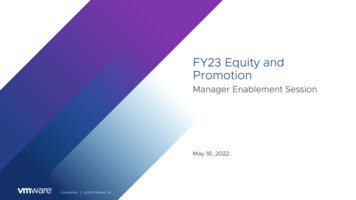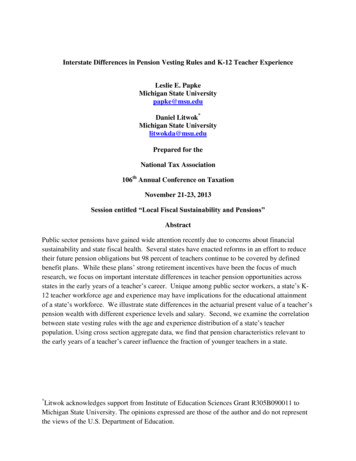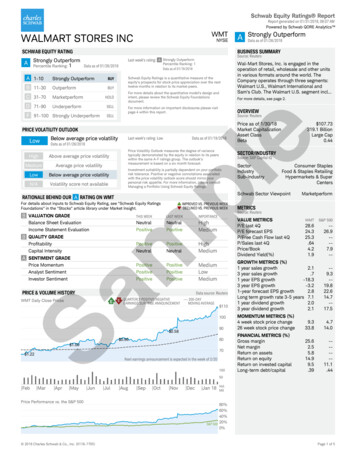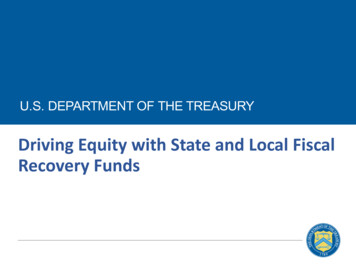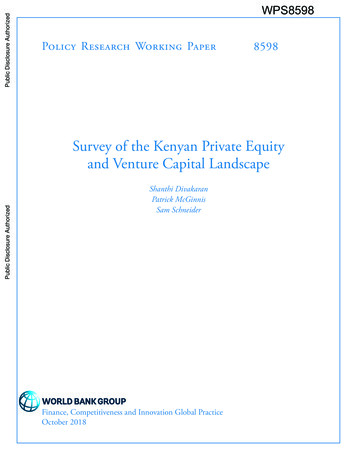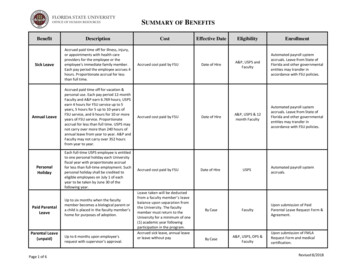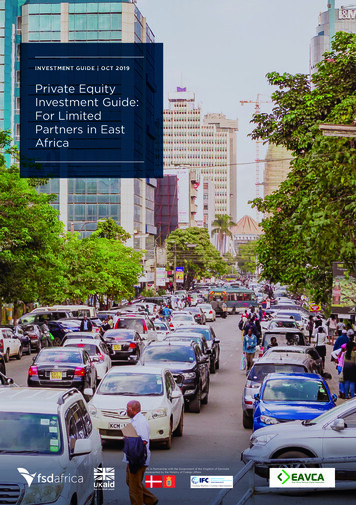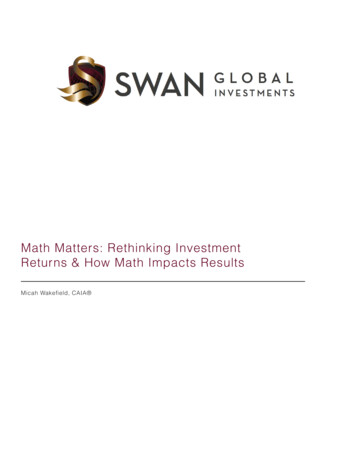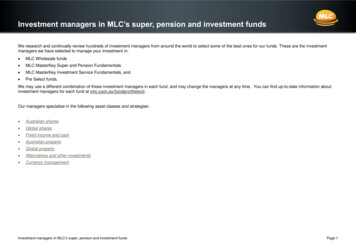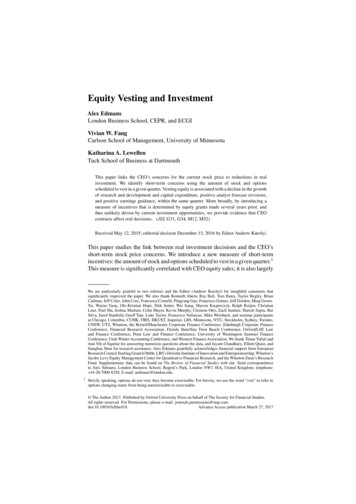
Transcription
Equity Vesting and InvestmentAlex EdmansLondon Business School, CEPR, and ECGIVivian W. FangCarlson School of Management, University of MinnesotaKatharina A. LewellenTuck School of Business at DartmouthThis paper links the CEO’s concerns for the current stock price to reductions in realinvestment. We identify short-term concerns using the amount of stock and optionsscheduled to vest in a given quarter. Vesting equity is associated with a decline in the growthof research and development and capital expenditure, positive analyst forecast revisions,and positive earnings guidance, within the same quarter. More broadly, by introducing ameasure of incentives that is determined by equity grants made several years prior, andthus unlikely driven by current investment opportunities, we provide evidence that CEOcontracts affect real decisions. (JEL G31, G34, M12, M52)Received May 12, 2015; editorial decision December 15, 2016 by Editor Andrew Karolyi.This paper studies the link between real investment decisions and the CEO’sshort-term stock price concerns. We introduce a new measure of short-termincentives: the amount of stock and options scheduled to vest in a given quarter.1This measure is significantly correlated with CEO equity sales; it is also largelyWe are particularly grateful to two referees and the Editor (Andrew Karolyi) for insightful comments thatsignificantly improved the paper. We also thank Kenneth Ahern, Ray Ball, Tom Bates, Taylor Begley, BrianCadman, Jeff Coles, John Core, Francesca Cornelli, Pingyang Gao, Francisco Gomes, Jeff Gordon, Moqi GroenXu, Wayne Guay, Ole-Kristian Hope, Dirk Jenter, Wei Jiang, Marcin Kacperczyk, Ralph Koijen, ChristianLeuz, Paul Ma, Joshua Madsen, Colin Mayer, Kevin Murphy, Clemens Otto, Zach Sautner, Haresh Sapra, RuiSilva, Jared Stanfield, Geoff Tate, Luke Taylor, Francesco Vallascas, Mike Weisbach, and seminar participantsat Chicago, Columbia, CUHK, FIRS, HKUST, Imperial, LBS, Minnesota, NYU, Stockholm, Sydney, Toronto,UNSW, UTS, Wharton, the Bristol/Manchester Corporate Finance Conference, Edinburgh Corporate FinanceConference, Financial Research Association, Florida State/Sun Trust Beach Conference, Oxford/LSE Lawand Finance Conference, Penn Law and Finance Conference, University of Washington Summer FinanceConference, Utah Winter Accounting Conference, and Western Finance Association. We thank Timur Tufail andAnn Yih of Equilar for answering numerous questions about the data, and Jayant Chaudhary, Elliott Quast, andJianghua Shen for research assistance. Alex Edmans gratefully acknowledges financial support from EuropeanResearch Council Starting Grant 638666, LBS’s Deloitte Institute of Innovation and Entrepreneurship, Wharton’sJacobs Levy Equity Management Center for Quantitative Financial Research, and the Wharton Dean’s ResearchFund. Supplementary data can be found on The Review of Financial Studies web site. Send correspondenceto Alex Edmans, London Business School, Regent’s Park, London NW1 4SA, United Kingdom; telephone: 44-20-7000-8258. E-mail: aedmans@london.edu.1 Strictly speaking, options do not vest; they become exercisable. For brevity, we use the word “vest” to refer tooptions changing status from being unexercisable to exercisable. The Author 2017. Published by Oxford University Press on behalf of The Society for Financial Studies.All rights reserved. For Permissions, please e-mail: 8Advance Access publication March 27, 2017
The Review of Financial Studies / v 30 n 7 2017driven by equity grants made several years prior, and thus unlikely to be relatedto current shocks to investment opportunities. We find that vesting equity isassociated with reductions in the growth rates of research and development(R&D) and capital expenditure, positive analyst forecast revisions, andpositive earnings guidance. These results suggest that vesting equity inducesCEOs to reduce investment in long-term projects and increase short-termearnings, and more broadly that CEO contracts have a causal effect on realdecisions.One of the most fundamental principles of corporate finance is that managersshould maximize firm value by trading off short-term and long-term cashflows based on shareholders’ discount rates. This principle underlies almostall research on corporate investment and is a central premise in leading financetextbooks. However, the myopia models of Stein (1988, 1989) predict that stockprice concerns will instead lead managers to overweight short-term cash flowsand forgo value-increasing long-term investments.Despite the importance of investment decisions in the research, teaching,and practice of corporate finance, there are very few tests of myopia, in partbecause short-term concerns are difficult to measure. Standard measures ofCEO incentives (e.g., Jensen and Murphy 1990; Hall and Liebman 1998)quantify his overall level of equity holdings. However, short-term concernsarise not from overall equity, but from the amount of equity that the CEOexpects to sell in the short term. Equity that the CEO plans to hold for thelong term may deter myopia (Edmans et al. 2012). Using actual equity sales tomeasure short-term incentives would be problematic since they are endogenouschoices of the CEO and thus likely correlated with omitted variables that alsodrive investment. For example, negative private information on firm prospectsmay cause him to sell equity and also cut investment. In addition, actual equitysales include unexpected liquidity sales (which will not affect investment) andso are a mismeasured proxy for anticipated sales.We thus study neither total equity holdings nor actual equity sales, butthe amount of equity that vests in a given quarter. As discussed earlier,vesting equity is largely driven by the schedule of equity grants made severalyears prior,2 and is highly correlated with actual short-term equity sales: aone-standard-deviation increase in vesting equity is associated with a risein same-quarter equity sales by 140,000, 16% of the average level. Theamount of vesting equity is also known to the CEO in advance, so he isable to change investment in anticipation. We construct this measure using theEquilar database, which tracks the vesting status of equity grants on an annualbasis, based on the Securities and Exchange Commission’s (SEC) increased2 Gopalan et al. (2014) show that most equity grants do not fully vest for three to five years, and vesting schedulesare largely predetermined at the time of the grant. However, in some cases, vesting is based on accounting orstock performance, which may be correlated with current investment opportunities. We address this concern inSection 2.1.2230
Equity Vesting and Investmentdisclosure requirements from 2006. By devising an algorithm that allows theestimation of vesting dates, we are able to calculate vesting equity on a quarterly(rather than only annual) basis, thus enabling more precise identification.We find that vesting equity is associated with significant declines inthe growth of five measures of investment, controlling for determinants ofinvestment opportunities and the firm’s ability to fund investment, othercomponents of CEO compensation (unvested equity, already-vested equity,salary, and bonus), CEO characteristics (age, tenure, and an indicator for newCEO), as well as year, quarter, and firm fixed effects. A one-standard-deviationincrease in vesting equity is associated with an annualized 0.2% decline ingrowth in R&D plus net capital expenditure (scaled by total assets), 11% of theaverage investment-to-assets ratio. The results continue to hold when removinggrants with performance-based vesting provisions, considering only vestingstock or vesting options, using vesting equity as an instrument for equity salesin a two-stage least squares (2SLS) analysis, excluding controls, and usingdifferent algorithms to estimate vesting dates.One interpretation of our results is that stock price concerns lead CEOs toforgo positive net present value (NPV) investments at the expense of long-runvalue (the myopia hypothesis). An alternative explanation is that the vestinginduced investment cuts are efficient: if CEOs have a general tendency tooverinvest, a focus on the short-term stock price could curb overinvestment (theefficiency hypothesis). This explanation still implies that CEO contracts affectreal decisions, but unlike the myopia hypothesis, the effect is not inefficient. Athird explanation is that boards schedule vesting dates to coincide with declinesin investment opportunities (the timing hypothesis). Indeed, Gopalan et al.(2014) show that the duration of executive compensation is longer for firms withmore R&D investments and higher market-to-book ratios (which indicate morevaluable long-term projects). This explanation requires that boards forecastquarter-level declines in investment opportunities several years in advance.Note that it is still consistent with myopia theories if boards believe that vestingequity exacerbates myopia and so try to ensure that equity does not vest whileinvestment opportunities are strong.Distinguishing between these alternative hypotheses is challenging, inparticular because we can only observe the level of investment and notits efficiency. Nevertheless, we perform indirect tests to evaluate them. Toinvestigate the timing hypothesis, we rerun our tests including only grantsissued at least two years prior, which are less likely to be correlated with currentinvestment opportunities; the results remain robust. To investigate the efficiencyhypothesis, we study changes in contemporaneous operating performance. Ifvesting equity induces the CEO to act more efficiently, we might expect him todo so by not only cutting unproductive investments but also improving otherdimensions of operating performance. However, we find no change in the ratioof the cost of goods sold to sales, the ratio of operating expenses to sales,or sales growth, suggesting that the investment cut is unlikely to be part of a2231
The Review of Financial Studies / v 30 n 7 2017general program to increase efficiency. Separately, we find that the link betweenvesting equity and investment growth is generally weaker in subsamples wherethe cost of myopia to the CEO is likely higher or its benefit lower, such as firmswith more blockholders (who have incentives to analyze a firm’s fundamentalvalue rather than current earnings), younger CEOs (who have greater careerconcerns and thus suffer more from long-run value erosion), and smaller sizeand lower age (which indicate superior investment opportunities).Next, we study how the reduction in investment, induced by vesting equity,might benefit the CEO by increasing his payoff from equity sales. A CEO maycommunicate the increased earnings that result from the investment cut to themarket before the earnings announcement through earnings guidance, publicdisclosures, press releases, or interviews. We first use analyst forecast revisionsto assess the extent and effectiveness of the CEO’s overall communication. Wefind that vesting equity is positively and significantly related to the increase inanalyst earnings forecasts within quarter q, the same time period in which theCEO sells equity. While forecast revisions measure the outcome of managerialcommunication, we also directly study one specific communication channel,earnings guidance. We find that vesting equity is associated with a higherlikelihood that the firm issues positive earnings guidance during the samequarter, but not negative guidance. We also show that CEOs’ equity salesare concentrated in a small window immediately following positive guidance,likely because guidance occurs just before a trading window in which insidersare allowed to sell. This suggests that CEOs are able to benefit from guidanceby selling shares immediately afterwards. Finally, we find that vesting equityis positively related to the likelihood that the announced earnings exceed theanalyst consensus forecast by a narrow margin, but not by a wide margin. Thisresult is consistent with the CEO communicating a level of positive earningsnews that allows him to maximize his benefit from the investment cuts withoutcreating a large risk of missing the forecast.This paper is related to a large literature on managerial myopia. In addition toStein (1988, 1989), other theories include Miller and Rock (1985), Narayanan(1985), Bebchuk and Stole (1993), Bizjak, Brickley, and Coles (1993),Goldman and Slezak (2006), Edmans (2009), and Benmelech, Kandel, andVeronesi (2010). Empirically, Graham, Harvey, and Rajgopal (2005) providesurvey evidence that 78% of executives would sacrifice long-term value tomeet earnings targets. Using standard measures of incentives that capture theCEO’s total equity holdings, Cheng and Warfield (2005), Bergstresser andPhilippon (2006), and Peng and Roell (2008) find a positive association withearnings management, but Erickson, Hanlon, and Maydew (2006) find no linkto accounting fraud. These conflicting results may arise because, theoretically,it is the sensitivity to the short-term stock price that induces myopia. In addition,total equity holdings are potentially endogenous, because they depend on theamount of equity a CEO has chosen to hold onto.2232
Equity Vesting and InvestmentOur study is also related to papers that analyze the vesting horizon of theCEO’s equity. Kole (1997) is the first to describe vesting horizons, but does notrelate them to firm behavior.3 Gopalan et al. (2014) are the first to undertakea systematic analysis of the horizon of a CEO’s incentives, also using Equilar.They introduce a new “duration” measure of CEO incentives and show howit varies across industries and with firm characteristics. They also link thismeasure to accruals,4 but do not investigate real outcomes because duration—unlike vesting equity—depends on current equity grants and is thus likelycorrelated with current shocks to investment opportunities.A contemporaneous paper by Ladika and Sautner (2016) shows that theadoption of FAS 123R induced some firms to accelerate option vesting, whichin turn led to a fall in investment. Our papers are complementary in thatthey employ different empirical strategies to analyze the relation betweenvesting and investment, and find consistent results. While Ladika and Sautner(2016) focus on a one-time shock, we study a panel of firms with vestingevents distributed over time. This broader setting allows us to quantify theresponsiveness of investment to vesting equity, rather than study the morespecific question of how investment responded to a change in accounting rules.Our paper also contributes to the broader literature on CEO compensation,beyond the specific topic of short-termism. Even though this literature issubstantial, very few papers show that incentive contracts affect managers’behavior, that is, that CEO pay actually matters. The survey of Frydmanand Jenter (2010) notes that “compensation arrangements are the endogenousoutcome of a complex process . this makes it extremely difficult to interpretany observed correlation between executive pay and firm outcomes as evidenceof a causal relationship.” This paper takes a step toward addressing theidentification challenge, by introducing a measure of CEO incentives—vestingequity—that is unlikely to be driven by the current contracting environment.Thus, our results suggest that compensation has real effects. Indeed, ouridentification using vesting equity has since been used in wider contexts.Gopalan, Huang, and Maharjan (2015) use vesting equity as an instrumentfor duration and examine its effect on CEO turnover; Salitskiy (2015) linksit to lower risk-taking; and Edmans et al. (2017) show that CEOs reallocatenews toward months in which their equity vests and away from adjacentmonths. Turning to alternative identification strategies, Shue and Townsend3 Some papers do not consider the horizon of equity incentives but do differentiate between unvested and vestedequity. Johnson, Ryan, and Tian (2009) show that vested stock is related to corporate fraud. Burns and Kedia(2006) and Efendi, Srivastava, and Swanson (2007) find that large holdings of vested options, particularly thosein the money, are positively related to managers’ propensity to misreport.4 Unlike real activities such as changing investment, accruals management may not affect the firm’s fundamentalvalue. Separately, Cohen, Dey, and Lys (2008) document a significant shift from accruals management to changesin investment and other discretionary expenses after the passage of the Sarbanes-Oxley Act of 2002, suggestingthat changes in investment are more relevant during our sample period. Graham, Harvey, and Rajgopal (2005)also find that “most earnings management is achieved via real actions as opposed to accounting manipulations”after Sarbanes-Oxley.2233
The Review of Financial Studies / v 30 n 7 2017(Forthcoming) use multi-year grant cycles as an instrument for option grantsto identify the effects of compensation contracts on CEO risk-taking; Flammerand Bansal (Forthcoming) conduct a regression discontinuity analysis ofshareholder proposals to increase long-term compensation and find that suchproposals improve long-run performance.1. Data and Variable Measurement1.1 Measuring short-term concernsOur empirical approach is motivated by standard models of managerial myopia.In such models, the CEO’s wealth in quarter q is typically given by: Wq Sq αq ωq Pq T q ωq s E(P q s ) ,(1)s 1where T is the number of periods, Wq is the manager’s wealth, Sq is cashsalary, Pq is the stock price in quarter q, and αq is the manager’s total number T qof shares, of which a fraction ωq is sold in quarter q. We have s 0 ωq s 1.The manager’s short-term incentives in quarter q—his incentives to increase PqdWby a given percentage—are given by E( dPqq Pq ) E(αq ωq Pq ), that is, the valueof shares that he plans to sell in quarter q. Standard measures of incentivesinstead capture αq Pq , that is, total dollar equity holdings. Using αq ωq Pq , theamount of equity actually sold in quarter q, to proxy for E(αq ωq Pq ) is alsoproblematic due to the endogeneity concerns discussed earlier.We thus introduce a new measure of incentives to capture E(αq ωq Pq ), theCEO’s concerns for the short-term stock price in particular: the effective dollarvalue of equity scheduled to vest in quarter q, converting options to shareequivalents using their deltas. Vesting equity leads to stock price concernsbecause risk-averse, undiversified executives should sell some equity uponvesting. While most CEOs hold vested equity, this may be due to variousexplicit or implicit constraints (documented by Armstrong, Core, and Guay2015). Vesting relaxes these constraints, allowing the CEO to reduce risk byselling equity.A first constraint results from ownership guidelines: requirements to holdequity in excess of a given multiple of salary or percentage of sharesoutstanding. These guidelines are typically satisfied only by vested equity(Core and Larcker 2002), and so vesting allows the CEO to sell equity withoutviolating the guidelines. Second, the CEO may hold vested equity voluntarilyfor control reasons—he wishes to maintain voting rights in excess of a particularthreshold. Since unvested equity does not provide voting rights, vesting allowsadditional sales without falling below the threshold. Third, the CEO may holda threshold level of vested equity to signal confidence in the firm. In addition toreleasing constraints, vesting stock also imposes a tax charge on the CEO and2234
Equity Vesting and Investmentso he may sell equity to pay the tax.5 Consistent with these points, we showin Section 2 that equity sales are strongly related to vesting equity, controllingfor holdings of already-vested equity. Note that our identification does notrequire the CEO to sell his entire equity upon vesting, only that equity vestingis significantly correlated with equity sales.We calculate vesting equity using Equilar. The SEC’s compensationdisclosure requirements, implemented in 2006, mandate companies to disclosegrant-level (rather than merely aggregate-level) information on each stock andoption award held by a top executive in their proxy statements, includingwhether the award is vested or unvested. Equilar tracks this information forRussell 3000 firms, versus ExecuComp, which covers only S&P 1500 firms.We purchase this data for 2006–2010.Equilar’s variable “Shares Acquired on Vesting of Stock” directly gives thenumber of shares that vest in a given year, either from previously restrictedstock or stock units, or long-term incentive plans. To calculate the number ofvesting options, we use grant-by-grant information on a given CEO’s newlyawarded options in year t, and his unvested options at the end of years t–1and t. We group these options by the strike price and expiry date. For a givenprice-date pair, we infer the number of vesting options using:VESTINGOPTNUMt UNVESTEDOPTNUMt 1 NEWOPTNUMt UNVESTEDOPTNUMt ,(2)where VESTINGOPTNUM is the number of vesting options, UNVESTEDOPTNUM is the number of unvested options, and NEWOPTNUM is the number ofnewly awarded options.The above approach yields the number of securities that vest over a givenyear, because Equilar provides only annual data. To closely match the timingof vesting equity to the timing of investment, we calculate vesting equity atthe quarterly level, since this is the highest frequency available for investmentmeasures. To do so, we assign vesting equity in a year to a particular quarterbased on the vesting date. For options, this is simple. Options vest and expireon the anniversary of a grant, and so we can use their expiry date to inferthe vesting date.6 For stock, there is no expiry date, and grant dates are onlyavailable for shares awarded after 2006 in Equilar. We thus use the followingalgorithm. We first attribute vesting shares to post-2006 awards for which weknow the grant dates from Equilar. Cliff-vesting grants vest at the end of thevesting period. For graded-vesting grants, we assume that they vest annuallyon a straight-line basis, following Gopalan et al. (2014). We then attribute the5 Restricted stock represents income and so taxation is triggered upon vesting, unless a Section 83(b) election (topay tax on the grant rather than vesting date) is made, which is uncommon.6 Gopalan et al. (2014) similarly assume that options vest on grant anniversaries, and we have checked thisassumption by manually investigating a subsample of proxy filings that provide the full vesting schedule.2235
The Review of Financial Studies / v 30 n 7 2017remaining vesting shares to pre-2006 grants. To approximate their grant dates,we use all grant dates of the post-2006 awards that we observe in Equilar.Specifically, if we observe n different grant dates in Equilar, we allocate theinferred vesting from pre-2006 grants evenly across the n dates.7 This stepassumes that firms grant restricted stock in the same quarter(s) of the year;indeed, out of the 1,758 sample firms that granted restricted stock more thanonce post 2006, 83% have repeated grants in the same month. Section 5 verifiesrobustness to other assumptions.Having identified the number of vesting securities, we calculate their delta:the number of shares a security is equivalent to, from an incentive standpoint.The delta of a share is 1; we calculate the delta of an option using the BlackScholes formula.8 We then sum across the deltas of all of the CEO’s vestingstock and options. The aggregate delta measures the dollar change in vestingequity for a 1 change in the stock price, and reflects the effective numberof vesting shares. To calculate the effective value of vesting equity in quarterq, we multiply the aggregate delta by Pq 1 . We label the resulting measureVESTING, and it represents the dollar change in vesting equity for a 100%change in price. Appendix B gives a sample calculation for one CEO-quarter.Our sample for the main analyses consists of 26,724 firm-CEO-quarters;see Table 1, Panel A, for the detailed sample selection procedure. As reportedin Table 1, Panel B, vesting equity has a mean of 785,000, with a mean of 566,000 ( 178,000) coming from vesting options (shares). Vesting equity iszero for 62% of the firm-quarters in our sample. The coefficient of variation(standard deviation divided by the mean) of VESTING is 2.2 when computedseparately for each CEO and then averaged, suggesting significant within-firmvariation. Even setting aside the variation due to price, the average coefficientsof variation are still sizable for the number of vesting shares and the numberof vesting options (2.2 and 2.3, respectively).1.2 Measurement of investmentOur first measure of investment is the quarterly change in R&D ( RD), scaledby lagged total assets. R&D is generally expensed and thus immediately reduces7 If the vesting equity, calculated from post-2006 grants with known vesting schedules, exceeds “Shares Acquiredon Vesting of Stock,” we decrease the amount of vesting equity from each grant proportionally. Of post-2006grants, 6.8% have an unknown vesting schedule and vesting period in Equilar. We combine them with pre-2006grants and apply our algorithm to the combination. Less than 1% of the grants vest only after CEO retirement;we exclude them.8 For the Black-Scholes inputs of firm volatility, dividend yield, and risk-free rate, we use Equilar for consistencywith our other compensation variables. For options that vest in year t , we use inputs as of the end of year t–1, andif unavailable, as of year t . If the data is missing in Equilar, we use year t–1’s inputs from ExecuComp, and yeart–1’s inputs from Compustat, in that order. If absent from the three databases, we calculate volatility using thestandard deviation of the firm’s stock returns over the past three years using the CRSP daily files; the risk-freerate using the Treasury Constant Maturity Rate with the closest term to a given option; and the dividend yieldusing the average of the firm’s dividend yield over the past five years using the Compustat annual files. If theexpiry date is missing from Equilar (which occurs for 96 out of 29,948 unvested option grants), we delete theoption.2236
Equity Vesting and InvestmentTable 1Sample selection and summary statisticsPanel A: Sample selectionFirm-CEO-years in Equilar for which we can calculate the price sensitivity of thevesting equity of quarter q , and that of unvested and already-vested equity in year t–1 for thesample period of fiscal year 2007 to 2010(–) Observations that cannot be matched to Compustat or CRSP(–) Observations associated with financial firms (SICs between 6000 and 6999)(–) Observations associated with utility firms (SICs between 4900 and 4949)Number of firm-CEO-yearsConverting firm-CEO-years to firm-CEO-quarters(–) Observations missing quarterly controlsNumber of firm-CEO-quarters in the final sampleNumber of unique firms in the final 2,043Panel B: Summary statisticsVariableMedian95%SDDependent variables of the main specification: Change in investment RDq26,724– 0.0070.0000.000 CAPEX q26,724– 0.0130.0000.000 NETINVq26,724– 0.0260.0010.000 RDCAPEX q26,724– 0.0200.0000.000 RDNETINVq26,724– 070.0100.0250.0140.029Key independent variables of the main specification: CEO incentives from vesting equity26,7240785,13904,457,005VESTING q26,7240177,89101,104,233VESTINGSTOCK 301,863,655Other independent variables of the main specification: Annual controls6,73005,656,4861,835,151UNVESTEDq 16,730 415,985 70,400,00013,300,000VESTEDq 1SALARY q 16,730 265,000670,194600,000BONUS q 16,7300167,7040CEOAGE q 16,730425454CEOTENURE q 16,730075NEWCEOq6,73000.00406,73042115FIRMAGE q 0,000205,000,000336,489483,780870.06416Other independent variables of the main specification: Quarterly controlsQq26,7240.5251.6871.260Qq 126,7240.5271.7111.28226,7244.6266.9316.732MVq 1MOM q 126,724– 0.3120.0290.00726,7240.0060.1990.116CASH q 1BOOKLEVq 126,7240.0000.2150.174RETEARN q 126,724– 2.557– 0.2000.162ROAq 126,724– enous variable of interest: Equity her operating performance measures26,385– 1.371SGRq COGS q26,325– 0.093 OPEXPq26,322– 0.169– 0.879– 0.004– 0.005– 0.9330.000– 0.002– 0.2630.0830.1470.4240.2720.376Summary statistics of the main variables used in our multivariate analysis. All continuous variables are winsorizedat the 1% and 99% levels. Variable definitions are in Appendix A.earnings. However, the cash flows created by R&D typically only arise in thelong term, and so it is difficult for even a forward-looking market to assessthem immediately and incorporate them into the stock price. Consistent with2237
The Review of Financial Studies / v 30 n 7 2017this view, prior literature finds that managers use R&D cuts to increase short-runearnings.9 Following Himmelberg, Hubbard, and Palia (1999), we set missingR&D values to zero. The results are robust to removing observations withmissing R&D, despite a much smaller sample.We also calculate the quarterly change in capital expenditure ( CAPEX )and net investment ( NETINV), scaled by lagged total assets. While CAPEXis taken directly from the cash flow statement, NETINV is the change in NetProperty, Plant, and Equipment from the balance sheet. The latter is net ofaccumulated depreciation while the former is not. Although capital expenditureis not expensed, it depresses earnings through raising depreciation. In addition,it is typically financed by reducing cash or increasing debt. This increasesa firm’s net interest expense, reducing earnin
stock performance, which may be correlated with current investment opportunities. We address this concern in . investment opportunities and the firm's ability to fund investment, other . earnings management, but Erickson, Hanlon, and Maydew (2006) find no link to accounting fraud. These conflicting results may arise because, theoretically,
